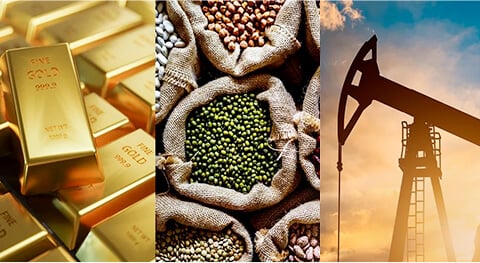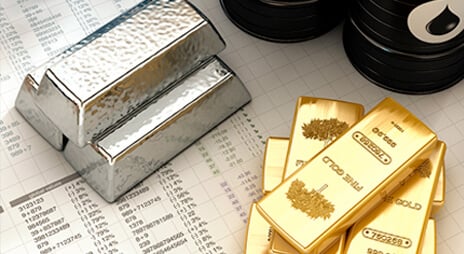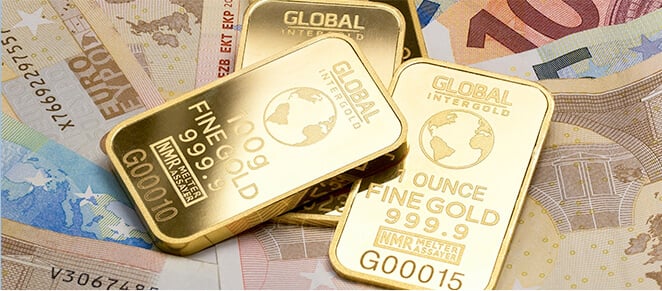
What are commodities
Commodities are items used in commerce or markets. Commodities are traded on different exchanges around the world and are usually traded as futures contracts. Each commodity traded on an exchange must meet certain standards and grades. They may have slight differences, but in the eyes of all producers there are only two types, soft commodities and hard commodities.
Commodities traded in futures contracts, that is, contracts that are delivered on a specified date at the price of the underlying asset, do not grant ownership of the physical commodity. AvaTrade, as a top CFD broker, provides a trading platform with a variety of commodity contracts for difference (CFD), which are contracts based on the price of the underlying asset and do not grant physical ownership. This type of contract does not require the actual holding of the underlying asset, but can be traded at any time, which is very popular among investors.
Classification of commodities
There is no official standard answer to the classification of commodities. Generally speaking, commodities are divided into soft commodities and hard commodities
Soft commodities
Refers to commodities that are grown, not mined. For example: crops such as sugar, cotton, wheat, and coffee. These products produced by farmers are extremely sensitive to climate and weather changes, and their prices are affected by the seasons.
Hard commodities
Refers to mining commodities, such as gold or other precious metals, oil, natural gas and other energy sources. Compared with soft commodities, the natural resource reserves of hard commodities are limited, the total amount will not increase suddenly, and the mining cost is higher.
Why trade commodities at AvaTrade
At AvaTrade, you can easily trade commodities such as precious metals and agricultural products, and enjoy
The benefits of a broker with seven levels of regulation in five continents around the world
-

Trading with competitive spreads
Commodities such as precious metals/agricultural products/crude oil
-

9 levels of regulation in five continents around the world
Praised by financial industry media
-

Flexible leverage
Up to 200:1
-

Can be widely used worldwide
MT4 and MT5 trading
-

Supports two-way trading
There is a possibility of profit in both ups and downs
-

5x24 hours 14 languages
One-to-one account manager online answers
What are the factors that affect commodity prices?
-
Supply and demand:
If supply and demand are balanced, prices should remain constant. But whenever the market thinks that supply will decrease due to weather or production cuts, prices tend to rise,
and vice versa, i.e., increased supply tends to push prices down.
-
Stock and Inventory:
The production of goods can be affected by factors such as weather, crop diseases, employee production problems, political and economic environment, which
create additional costs such as taxes, trade laws, government subsidies, etc.
-
Currency Strength:
The link between the world's most actively traded commodities and currency pairs is common. Most commodities are priced in US dollars, so in order to better predict price trends, it is wise to pay attention to the trend of the US dollar index.
-
Inflation:
The prices of commodities usually fluctuate with inflation, mainly precious metal products such as gold and silver. Generally, the inflation in major Western countries
is higher, the greater the demand for gold as a hedge.

What are the advantages of commodity trading
Commodity trading can be a good asset portfolio and has the potential to increase returns. Although commodities
have no dividends, they will not go bankrupt

-

Can resist inflation, commodity prices tend to rise in an inflationary environment
-

When the market is under pressure, precious metals can be used as a safe-haven product. Gold is often negatively correlated with the dollar and the U.S. stock market,
So when money flees these assets, it tends to turn to gold
-

Can make huge profits: Commodity CFDs are traded on margin, which means higher potential returns
And risk
-

Low deposit threshold, only 100 US dollars, you can open an account, and also supports simulated account practice
-

Supports two-way trading, long and short-term trading, and there is a possibility of profit in both rising and falling prices
What are commodities
Commodities are items used in business or markets. Commodities are traded on different exchanges around the world, usually as futures contracts. Each commodity traded on an exchange must meet certain standards and grades, and they may have slight differences, but in the eyes of all producers there are only two types, soft commodities and hard commodities.
Commodities traded in futures contracts, that is, contracts that deliver on a specified date at the price of the underlying asset, do not grant ownership of the physical commodity. AvaTrade, as a top CFD broker, provides a trading platform with a variety of commodity contracts for difference (CFDs), that is, contracts based on the price of the underlying asset that do not grant physical ownership. This type of contract does not require actual possession of the underlying asset, but can be traded at any time and is very popular among investors.

Classification of commodities
There is no official standard answer to the classification of commodities. Generally speaking, commodities are divided into soft commodities and hard commodities.
Soft commodities
Refers to commodities that are planted, not mined. For example: crops such as sugar, cotton, wheat, and coffee. These products produced by farmers are extremely sensitive to climate and weather changes, and their prices are affected by the seasons.
Hard commodities
Refers to mining commodities, such as gold or other precious metals, oil, natural gas and other energy sources. Compared with soft commodities, the natural resource reserves of hard commodities are limited, the total amount will not increase suddenly, and the mining cost is higher.
Why trade commodities at AvaTrade
At AvaTrade, you can easily trade commodities such as precious metals and agricultural products, and enjoy the benefits of a 7-level regulated broker on five continents around the world
-

With competitive spreads
Trading commodities such as precious metals
-

9 levels of regulation in five continents
Praised by financial industry media
-

Flexible leverage
Up to 200:1
-

Widely used in the world
Trading on MT4 and MT5
-

Supports two-way trading
There is a possibility of profit in both ups and downs
-

5x24 hours
One-to-one customer service online answers
What are the factors that affect commodity prices?
-
Supply and Demand:
If supply and demand are balanced, prices should remain unchanged. But whenever the market thinks that supply will decrease due to weather or production cuts, prices tend to rise, and vice versa, i.e., increased supply tends to push prices down.
-
Stock and Inventory:
The production of goods may be affected by factors such as weather, crop diseases, employee production problems, political and economic environment, which may result in additional costs such as taxes, trade laws, government subsidies, etc.
-
Currency Strength:
The link between the world's most actively traded commodities and currency pairs is common. Most commodities are denominated in US dollars, so in order to better predict the price direction, it is wise to pay attention to the trend of the US dollar index.
-
Inflation:
The prices of commodities usually change with inflation, mainly precious metal products such as gold and silver. Generally, the higher the inflation in major Western countries, the greater the demand for gold as a hedge.

What are the advantages of commodity trading
Commodity trading can be a good asset portfolio and has the potential to increase returns. Although commodities do not pay dividends, they will not go bankrupt.
-

Can resist inflation, commodity prices tend to rise in an inflationary environment
-

Precious metals can serve as a safe haven when markets are under pressure. Gold is often negatively correlated with the U.S. dollar and U.S. stocks, so when money flees those assets, it tends to turn to gold
-

You can make big profits: Commodity CFDs are traded on margin, which means higher potential returns and risks
-

Low deposit threshold, only 100 US dollars is required to open an account, and simulated account practice is also supported
-

Supports two-way trading, long and short-term trading, and both rising and falling prices can make profits















